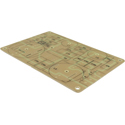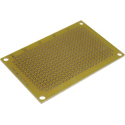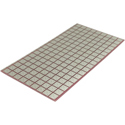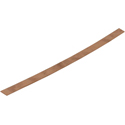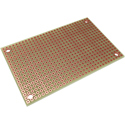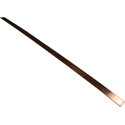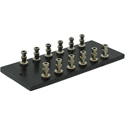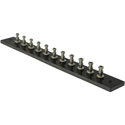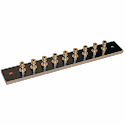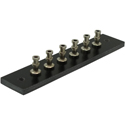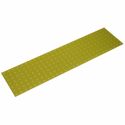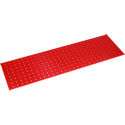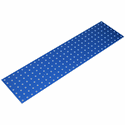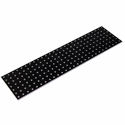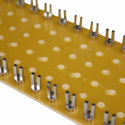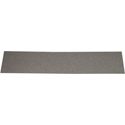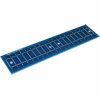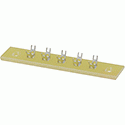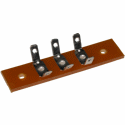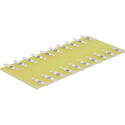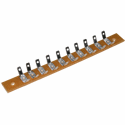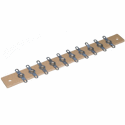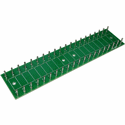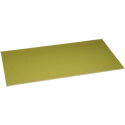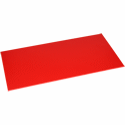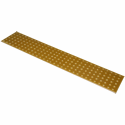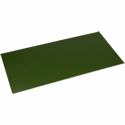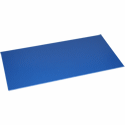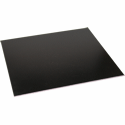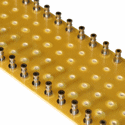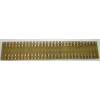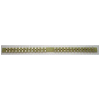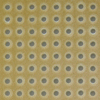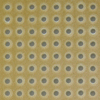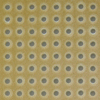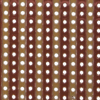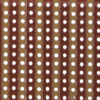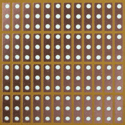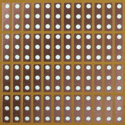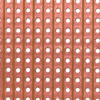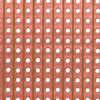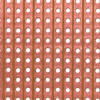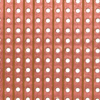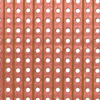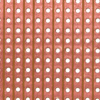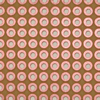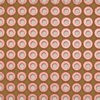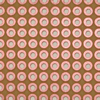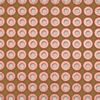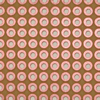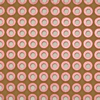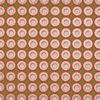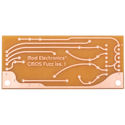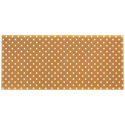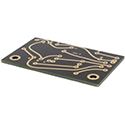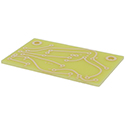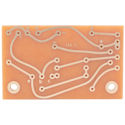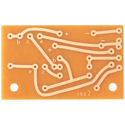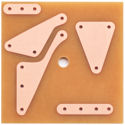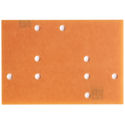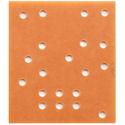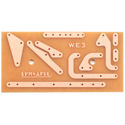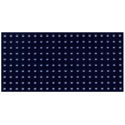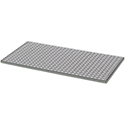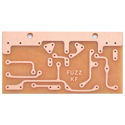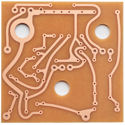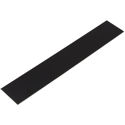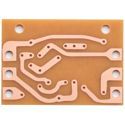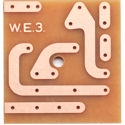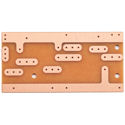0
item(s)
Cart is empty
PC Boards
Products
Intertechnik LP/2WEG/G
Intertechnik PCB Board LP/2WEG/G. Universal circuit board 2-way. FR 4 Epoxy, copper plating 35 µm, tin plated surface 70 µm.
€17,77
including VAT
19%
, [plus shipping]
Board PPH-072
Board size: 72x47mm. Pad-per-hole board, thickness 1,5mm. Hole spacing 2,54mm, hole size 1,0mm. 371 holes with 4 mounting holes in the corners.
€2,84
including VAT
19%
, [plus shipping]
Mundorf UNIP13
Size: 94 x 182 mm. The multiboard allows quick and easy construction using individual parts and prototypes. The soldered side is divided into many copper areas. Each area is measuring approx. 10 * 10 mm. The components are attached directly onto the solder side and the connection wires are soldered to the copper surface.
€16,89
including VAT
19%
, [plus shipping]
Mundorf CUB300-1-15
Copper strip for making connections. 300x1x15mm.
€2,67
including VAT
19%
, [plus shipping]
Board BB-PB-1
Prototyping circuit board that has a general purpose pad-per-hole pattern making it great for general purpose analog and digital use. It is a double-sided board with plated holes, which allows components to be easily soldered to either side of the board. A square pad is provided every 5th hole, which makes it easy to align components on the top and bottom of the board.
€4,56
including VAT
19%
, [plus shipping]
Mundorf CUB300-1-10
Copper strip for making connections. 300x1x10mm.
€2,03
including VAT
19%
, [plus shipping]
Turret Strip TS-23
Turret strip with 23 turrets. Size: 241 x 16mm.
€7,58
including VAT
19%
, [plus shipping]
Turret Strip TS-12
Turret strip with 12 turrets. Size: 77 x 32mm.
€6,60
including VAT
19%
, [plus shipping]
Turret Strip TS-11
Turret strip with 11 turrets. Size: 127 x 16mm.
€4,99
including VAT
19%
, [plus shipping]
Turret Strip TS-9
Turret strip with 9 turrets. Size: 95 x 16mm.
€4,51
including VAT
19%
, [plus shipping]
Turret Strip TS-6
Turret strip with 6 turrets. Size: 67 x 16mm.
€3,75
including VAT
19%
, [plus shipping]
Turret Board H-YELLOW
Blank board, yellow color. Size: 258x67mm. Thickness: 2mm. 189 holes.
€10,41
including VAT
19%
, [plus shipping]
Turret Board H-RED
Blank board, red color. Size: 258x67mm. Thickness: 3mm. 189 holes.
€9,92
including VAT
19%
, [plus shipping]
Turret Board H-GREEN
Blank board, green color. Size: 258x67mm. Thickness: 2mm. 189 holes.
€9,02
including VAT
19%
, [plus shipping]
Turret Board H-BLUE
Blank board, blue color. Size: 258x67mm. Thickness: 2mm. 189 holes.
€9,20
including VAT
19%
, [plus shipping]
Turret Board H-BLACK
Blank board, black color. Size: 258x67mm. Thickness: 2mm. 189 holes.
€9,92
including VAT
19%
, [plus shipping]
Forked Turret Board
Turret board, thickness 2,0mm. Length: 307mm. Width: 60mm. Two rows with 30 forked turret contacts each.
€14,61
including VAT
19%
, [plus shipping]
Fiber board, vulcanized
Fiber board, vulcanized. Size: 380 x 76mm. Thickness: 1,5mm.
€3,14
including VAT
19%
, [plus shipping]
Tag Board blue 200x45x3mm
Blue epoxy, thickness 3,0mm. Length: 200mm. Width: 45mm. Two rows with 2x20 contacts each.
€6,78
including VAT
19%
, [plus shipping]
Tag board 5P-42
Pertinax tag board. Thickness: 1,5mm. Size: 40x9mm length. 1 row with 5 silver plated contacts. Contact distance 6mm.
€2,14
including VAT
19%
, [plus shipping]
Tag board 3P-32
Hardpaper tag board. Size: 32x12mm length. 3 contacts. Contact distance 8mm.
€1,93
including VAT
19%
, [plus shipping]
Tag board 2x10P-80
Pertinax tag board. Thickness: 1,5mm. Size: 80x38mm length. 2 rows with 10 silver plated contacts each. Contact distance 8mm.
€5,83
including VAT
19%
, [plus shipping]
Tag board 10P-88
Hardpaper tag board. Size: 88x12mm length. 10 contacts. Contact distance 8mm.
€5,05
including VAT
19%
, [plus shipping]
Tag board 10P-120
Hardpaper tag board. Size: 120x12mm length. 10 contacts. Contact distance 10mm.
€2,44
including VAT
19%
, [plus shipping]
Board TAG-40
Tag board, high quality. Size: 200mm x 45mm, 2 x 20 turrets.. Thickness: 2mm.
€13,34
including VAT
19%
, [plus shipping]
Board FR4-YELLOW
Epoxy FR4 board. Length: 300mm. Width: 150mm. Thickness: 2mm.
Yellow color.
Yellow color.
€9,21
including VAT
19%
, [plus shipping]
Board FR4-RED
Epoxy FR4 board. Length: 300mm. Width: 150mm. Thickness: 2mm.
Red color.
Red color.
€9,21
including VAT
19%
, [plus shipping]
Board FR4-HOLE
Epoxy turret board. Length: 300mm. Width: 60mm. Thickness: 2mm.
6 Rows of holes with 30 holes each. Hole diameter: 2,5mm. Distance between holes: 10mm.
6 Rows of holes with 30 holes each. Hole diameter: 2,5mm. Distance between holes: 10mm.
€8,66
including VAT
19%
, [plus shipping]
Board FR4-GREEN
Epoxy FR4 board. Length: 300mm. Width: 150mm. Thickness: 3mm.
Green color.
Green color.
€9,21
including VAT
19%
, [plus shipping]
Board FR4-BLUE
Epoxy FR4 board. Length: 300mm. Width: 150mm. Thickness: 2mm.
Blue color.
Blue color.
€9,21
including VAT
19%
, [plus shipping]
Board FR4-BLACK
Epoxy FR4 board. Length: 300mm. Width: 180mm. Thickness: 2mm.
Black color.
Black color.
€9,21
including VAT
19%
, [plus shipping]
Turret Board RND-30-YE
Turret board, thickness 2,0mm. Length: 307mm. Width: 60mm. Two rows with 30 round turret contacts each.
€17,20
including VAT
19%
, [plus shipping]
Soldering Strip 2x27 terminals, 30cm
Epoxy, thickness 1,5mm
€6,25
including VAT
19%
, [plus shipping]
Soldering Strip 1x26 terminals, 30cm
Epoxy, thickness 1,5mm
€3,06
including VAT
19%
, [plus shipping]
Board HPR-160
Hole board with no copper pads, thickness 1,5mm. Hole spacing 2,54mm, hole size 1,0mm, 39 rows of holes.
Size: 160x100mm.
Size: 160x100mm.
€2,38
including VAT
19%
, [plus shipping]
Board HPR-100
Hole board with no copper pads, thickness 1,5mm. Hole spacing 2,54mm, hole size 1,0mm, 39 rows of holes.
Size: 100x100mm.
Size: 100x100mm.
€1,61
including VAT
19%
, [plus shipping]
Board HPR-050
Hole board with no copper pads, thickness 1,5mm. Hole spacing 2,54mm, hole size 1,0mm, 39 rows of holes.
Size: 50x100mm.
Size: 50x100mm.
€1,21
including VAT
19%
, [plus shipping]
Board FHPCU-160
Hardpaper board (FR2) with photoactive copper plating (35um). Board thickness 1,5mm.
Size: 160x100mm.
Size: 160x100mm.
€2,89
including VAT
19%
, [plus shipping]
Board FHPCU-075
Hardpaper board (FR2) with photoactive copper plating (35um). Board thickness 1,5mm.
Size: 75x100mm.
Size: 75x100mm.
€1,39
including VAT
19%
, [plus shipping]
Board FHPCU-050
Hardpaper board (FR2) with photoactive copper plating (35um). Board thickness 1,5mm.
Size: 50x100mm.
Size: 50x100mm.
€1,21
including VAT
19%
, [plus shipping]
Board FEPCU-300x250
Epoxy board with photoactive copper plating (35um). Board thickness 1,5mm.
Size: 300x250mm.
Size: 300x250mm.
€14,66
including VAT
19%
, [plus shipping]
Board FEPCU-200x150
Epoxy board with photoactive copper plating (35um).
Size: 200x150mm.
Size: 200x150mm.
€5,32
including VAT
19%
, [plus shipping]
Board FEPCU-160
Epoxy board with photoactive copper plating (35um). Board thickness 1,5mm.
Size: 160x100mm.
Size: 160x100mm.
€3,01
including VAT
19%
, [plus shipping]
Board FEPCU-075
Epoxy board with photoactive copper plating (35um). Board thickness 1,5mm.
Size: 75x100mm.
Size: 75x100mm.
€1,62
including VAT
19%
, [plus shipping]
Board FEPCU-050
Epoxy board with photoactive copper plating (35um). Board thickness 1,5mm.
Size: 50x100mm.
Size: 50x100mm.
€1,23
including VAT
19%
, [plus shipping]
Board EPCU2X-160
Epoxy board with double sided copper plating (35um).
Size: 160x100mm.
Can be used with Positive spray (SKU20765) to manufacture circuit boards.
Size: 160x100mm.
Can be used with Positive spray (SKU20765) to manufacture circuit boards.
€4,11
including VAT
19%
, [plus shipping]
Board EPCU-300x200
Epoxy board with copper plating (35um). Board thickness 1,5mm.
Size: 300x200mm.
Size: 300x200mm.
€7,02
including VAT
19%
, [plus shipping]
Board EPCU-200x160
Epoxy board with copper plating (35um). Board thickness 1,5mm.
Size: 200x160mm.
Size: 200x160mm.
€3,93
including VAT
19%
, [plus shipping]
Board EPCU-200x100
Epoxy board with copper plating (35um). Board thickness 1,5mm.
Size: 200x100mm.
Size: 200x100mm.
€2,64
including VAT
19%
, [plus shipping]
Board EPCU-160
Epoxy board with copper plating (35um). Board thickness 1,5mm.
Size: 160x100mm.
Can be used with Positive spray (SKU20765) to manufacture circuit boards.
Size: 160x100mm.
Can be used with Positive spray (SKU20765) to manufacture circuit boards.
€2,48
including VAT
19%
, [plus shipping]
Board EPCU-120
Epoxy board with copper plating (35um). Board thickness 1,5mm
Size: 120x80mm.
Can be used with Positive spray (SKU20765) to manufacture circuit boards.
Size: 120x80mm.
Can be used with Positive spray (SKU20765) to manufacture circuit boards.
€1,82
including VAT
19%
, [plus shipping]
Board BGD-FEPCU-160
High quality board made by Bungard. Epoxy board (FR4 basis material, fibre reinforced with UV blocker. Photoactive copper plating (35um). Board thickness 1,5mm.
Size: 160x100mm.
Size: 160x100mm.
€3,07
including VAT
19%
, [plus shipping]
Board BGD-FEPCU-075
High quality board made by Bungard. Epoxy board (FR4 basis material, fibre reinforced with UV blocker. Photoactive copper plating (35um). Board thickness 1,5mm.
Size: 75x100mm.
Size: 75x100mm.
€1,80
including VAT
19%
, [plus shipping]
Board SR5-160
Stripboard with strips every 5,08mm. Board thickness 1,5mm. Hole spacing 2,54mm, hole size 1,0mm. 20 rows of holes with copper, 19 rows of holes without copper.
Size: 160x100mm.
Size: 160x100mm.
€1,83
including VAT
19%
, [plus shipping]
Board SR5-050
Stripboard with strips every 5,08mm. Board thickness 1,5mm. Hole spacing 2,54mm, hole size 1,0mm. 20 rows of holes with copper, 19 rows of holes without copper.
Size: 50x100mm.
Size: 50x100mm.
€0,68
including VAT
19%
, [plus shipping]
Board PS-160
Strips of three connected holes. Board thickness 1,5mm. Hole spacing 2,54mm. Width 100mm. Length: 160mm.
€2,46
including VAT
19%
, [plus shipping]
Board PS-050
Strips of three connected holes. Board thickness 1,5mm. Hole spacing 2,54mm. Width 100mm. Length: 50mm.
€1,04
including VAT
19%
, [plus shipping]
Board STR-500
Stripboard, thickness 1,5mm. Hole spacing 2,54mm, hole size 1,0mm
Size: 500x100mm.
Size: 500x100mm.
€6,44
including VAT
19%
, [plus shipping]
Board STR-200
Stripboard, thickness 1,5mm. Hole spacing 2,54mm, hole size 1,0mm
Size: 200x100mm.
Size: 200x100mm.
€2,32
including VAT
19%
, [plus shipping]
Board STR-160
Stripboard, thickness 1,5mm. Hole spacing 2,54mm, hole size 1,0mm, 39 rows of holes.
Size: 160x100mm.
Size: 160x100mm.
€1,87
including VAT
19%
, [plus shipping]
Board STR-100
Stripboard, thickness 1,5mm. Hole spacing 2,54mm, hole size 1,0mm, 39 rows of holes.
Size: 100x100mm.
Size: 100x100mm.
€1,31
including VAT
19%
, [plus shipping]
Board STR-075
Stripboard, thickness 1,5mm. Hole spacing 2,54mm, hole size 1,0mm, 39 rows of holes.
Size: 75x100mm.
Size: 75x100mm.
€1,19
including VAT
19%
, [plus shipping]
Board STR-050
Stripboard, thickness 1,5mm. Hole spacing 2,54mm, hole size 1,0mm, 39 rows of holes.
Size: 50x100mm.
Size: 50x100mm.
€0,86
including VAT
19%
, [plus shipping]
Board PPH-500
Pad-per-hole board, thickness 1,5mm. Hole spacing 2,54mm, hole size 1,0mm, 39 rows of holes. Size: 500x100mm.
€10,50
including VAT
19%
, [plus shipping]
Board PPH-200
Pad-per-hole board, thickness 1,5mm. Hole spacing 2,54mm, hole size 1,0mm, 39 rows of holes. Size: 200x100mm.
€3,20
including VAT
19%
, [plus shipping]
Board PPH-160
Pad-per-hole board, thickness 1,5mm. Hole spacing 2,54mm, hole size 1,0mm, 39 rows of holes.
Size: 160x100mm.
Size: 160x100mm.
€2,25
including VAT
19%
, [plus shipping]
Board PPH-150
Pad-per-hole board, thickness 1,5mm. Hole spacing 2,54mm, hole size 1,0mm, 39 rows of holes. Size: 150x100mm.
€2,39
including VAT
19%
, [plus shipping]
Board PPH-100
Pad-per-hole board, thickness 1,5mm. Hole spacing 2,54mm, hole size 1,0mm, 39 rows of holes.
Size: 100x100mm.
Size: 100x100mm.
€1,44
including VAT
19%
, [plus shipping]
Board PPH-075
Pad-per-hole board, thickness 1,5mm. Hole spacing 2,54mm, hole size 1,0mm, 39 rows of holes.
Size: 75x100mm.
Size: 75x100mm.
€1,19
including VAT
19%
, [plus shipping]
Board PPH-050
Pad-per-hole board, thickness 1,5mm. Hole spacing 2,54mm, hole size 1,0mm, 39 rows of holes.
Size: 50x100mm.
Size: 50x100mm.
€0,82
including VAT
19%
, [plus shipping]
Charge Pump 3PDT Board +/- 9V
3PDT switch mounted charge pump PCB for effects requiring both +9V and -9V. This small PCB simplifies the wiring of 3PDT foot switches in guitar pedals while also offering ±9V when used with a standard +9V power supply.
€2,98
including VAT
19%
, [plus shipping]
Charge Pump 3PDT Board 18V
3PDT switch mounted charge pump PCB for +18V effects. This small PCB simplifies the wiring of 3PDT foot switches in guitar pedals while also offering +18V when used with a standard +9V power supply.
€2,98
including VAT
19%
, [plus shipping]
CMOS Fuzz Board
This board is for a CMOS fuzz topology popularized by Craig Anderton’s Tube Sound Fuzz from the mid-70s. The board uses a new design with old-school traces on phenolic substrate for an era-appropriate look. Phenolic boards are found in many vintage electronics before the use of fiberglass became common.
€5,95
including VAT
19%
, [plus shipping]
Diagonal Perfboard
Triangle Big Muff style circuit board made with a phenolic substrate for an even closer match to the vintage production boards. Phenolic boards are found in many vintage electronics before the use of fiberglass became common.
€5,36
including VAT
19%
, [plus shipping]
Fuzz Face Iss.1 Style Board Black
This black color PCB is a recreation of the iss. 1 circuit board found in classic Fuzz Face pedals. When drawing the layout, multiple originals were closely referenced to ensure a proper match and fit. The copper traces are gold plated providing protection from corrosion indefinitely. This classic board fits the mounting holes on both original and reproduction Fuzz Face enclosures.
€6,16
including VAT
19%
, [plus shipping]
Fuzz Face Iss.1 Style Board Natural
This natural color PCB is a recreation of the iss. 1 circuit board found in classic Fuzz Face pedals. When drawing the layout, multiple originals were closely referenced to ensure a proper match and fit. The copper traces are gold plated providing protection from corrosion indefinitely. This classic board fits the mounting holes on both original and reproduction Fuzz Face enclosures.
€6,16
including VAT
19%
, [plus shipping]
Fuzz Face Iss.1 Style Board Phenolic
Iss. 1 fuzz PCB made with a phenolic substrate for an even closer match to the vintage production boards. This PCB is a recreation of the iss. 1 circuit board found in classic Fuzz Face pedals.
€9,85
including VAT
19%
, [plus shipping]
Fuzz Face Iss.2 Style Board Phenolic
Iss. 2 fuzz PCB made with a phenolic substrate for an even closer match to the vintage production boards. This PCB is a recreation of the iss. 2 circuit board found in classic Fuzz Face pedals.
€7,39
including VAT
19%
, [plus shipping]
HS Treble Booster Style Board
This board is a recreation of the circuit board found in the Hornby Skewes ‘Treble Booster’ pedal. The board is styled after a version of the silicon Treble Booster but can be used for the germanium version as well.
€9,85
including VAT
19%
, [plus shipping]
Maestro FZ-1A Style Board
FZ-1 fuzz circuit board made with a phenolic substrate for an even closer match to the vintage production boards. Phenolic boards are found in many vintage electronics before the use of fiberglass became common. This board is a recreation of the circuit board found in Maestro FZ-1 pedals. The board is styled after the original version that can also be found in early serial Maestro FZ-1A pedals.
€6,16
including VAT
19%
, [plus shipping]
Mosrite Fuzzrite style board
Eyelet-Rite fuzz circuit board made with a phenolic substrate for an even closer match to the vintage production boards. Phenolic boards are found in many vintage electronics before the use of fiberglass became common. This board is a recreation of the circuit board found in the germanium Mosrite Fuzzrite pedals. The board is styled after the point to point version that used eyelets.
€6,16
including VAT
19%
, [plus shipping]
Phenolic Perfboard 15,6 x 8cm
Perfboard / padboard made with a phenolic substrate. Phenolic boards are found in many vintage electronics before the use of fiberglass became common. This perfboard features a 0.1 inch modern spacing. The board has 60 x 30 holes with squared copper pads on one side of the board. The copper is surface-treated, making soldering easier than most protoboards and also ensuring a long shelf life.
€9,52
including VAT
19%
, [plus shipping]
Pseudo Eyelet Board Generic AB763 Size
Pseudo eyelet boards with 3 rows of 1/2 inch spacing. These 2mm thick boards have a vertical spacing of 1 inch from row to row. The pseudo eyelet PCBs have similar styling to the eyelet/fiberboard used in vintage equipment. The size and layout of the 3 x 29 works well for AB763 style builds. For a blank board to pair with this one for use as an insulator, see SKU 77119.
€11,90
including VAT
19%
, [plus shipping]
Shatterbox Style Board
This board is a recreation of the circuit board found in the Shatterbox pedal. The board is styled after the later version with a printed circuit rather than a stripboard construction. This is the same board that was used in the 'split board' version which can be built by cutting the board down the middle to separate the fuzz section from the treble booster section.
€11,09
including VAT
19%
, [plus shipping]
Stripboard Vintage Style Black
Black Stripboard featuring a 0.15 inch (0,381 mm) vintage spacing. This spacing is great for vintage-style builds and more easily accommodates axial capacitors and other larger sized vintage parts like resistors and transistors. The board has a 20x10 grid (10 strips) and easily fits into 1590BB style enclosures and larger vintage-style fuzz enclosures,
€3,80
including VAT
19%
, [plus shipping]
Stripboard Vintage Style Natural
Natural Stripboard featuring a 0.15 inch (0,381 mm) vintage spacing. This spacing is great for vintage-style builds and more easily accommodates axial capacitors and other larger sized vintage parts like resistors and transistors. The board has a 20x10 grid (10 strips) and easily fits into 1590BB style enclosures and larger vintage-style fuzz enclosures,
€3,80
including VAT
19%
, [plus shipping]
Supa Fuzz Style Board
This board is a recreation of the circuit board found in the SupaFuzz pedal. The board is styled after the first version that Marshall produced which featured a printed circuit rather than a stripboard construction.
€6,16
including VAT
19%
, [plus shipping]
Tonebender Mk.3 Mk.4 Style Board
MKIII & MKIV fuzz circuit board made with a phenolic substrate for an even closer match to the vintage production boards. This board is a recreation of the circuit board found in Vox Tone Bender MKIII pedals. The board is styled after the non-reverse version that can also be found in the Park Fuzz Sound, Rotosound Fuzz, and the MKIV Tone Bender.
€9,85
including VAT
19%
, [plus shipping]
Tonebender MkI Goldie board
Tonebender MkI 'Goldie' style circuit board made with a phenolic substrate for an even closer match to the vintage production boards. Phenolic boards are found in many vintage electronics before the use of fiberglass became common. The mounting holes are spaced to fit our Vintage Fuzz PCB Bracket (SKU 74834).
€4,11
including VAT
19%
, [plus shipping]
Turret Board Blank AB763 Size
AB763 sized blank FR-4 epoxy boards perfect for custom turret or eyelet boards. With no predilled holes, builders can make clean custom layouts for their projects. This board can also be used as the insulator for the SKU 77120 generic AB763 layout pseudo eyelet board. Black FR-4. Length: 37mm (14,5 inch). Width: 6,35mm (2,5 inch). Thickness: 2mm.
€11,90
including VAT
19%
, [plus shipping]
V828 Vox Tone Bender Style Board
This board is a recreation of the circuit board found in the V828 Vox Tone Bender pedals. The board is styled after the Italian made version which was also sold as the Jen Fuzz.
€6,16
including VAT
19%
, [plus shipping]
Zonk II Style Board
This board is a recreation of the circuit board found in the Zonk II pedal. The board is styled after the version that featured silicon transistors and a printed circuit rather than a stripboard construction. It is actually a cut down version of the Shatterbox PCB using only the fuzz side of that pedal.
€9,85
including VAT
19%
, [plus shipping]
Zonk Machine Style Board
This board is a recreation of the circuit board found in the Zonk Machine pedal. The board is styled after the early version that featured a printed circuit rather than a stripboard construction.
€11,09
including VAT
19%
, [plus shipping]

